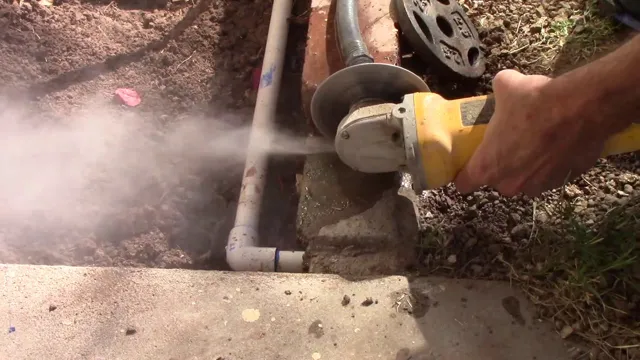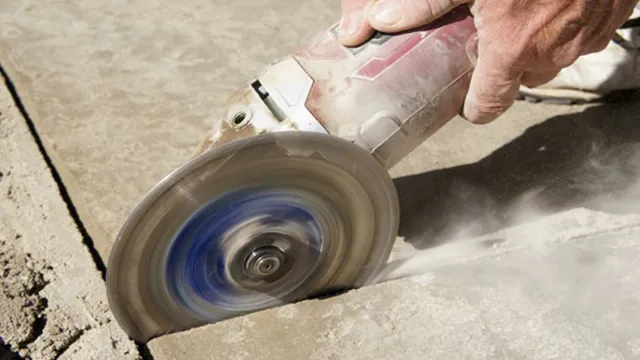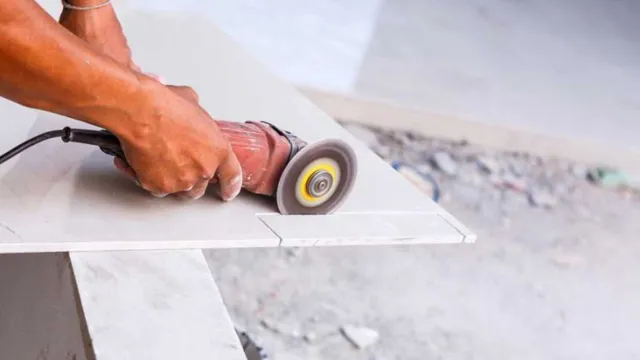How to Cut Concrete with an Angle Grinder: A Comprehensive Guide

Do you need to cut concrete but don’t want to hire a professional? Using an angle grinder is a great option for DIY enthusiasts who want to save money and take on the challenge themselves. With the right technique and safety precautions, anyone can successfully cut concrete with an angle grinder. An angle grinder is a versatile tool that can be used for a variety of purposes, including cutting, grinding, and polishing.
However, when it comes to cutting concrete, the right blade is crucial. Look for a diamond blade specifically designed for cutting concrete, as this will provide the best results. It’s also important to wear protective gear, including safety glasses and gloves, as well as a dust mask to protect yourself from the dust created by the cutting process.
Once you have the right blade and safety gear, it’s time to get started. Begin by carefully marking the area of the concrete you want to cut, using a chalk line or other marking tool. Then, slowly and carefully guide the angle grinder along the marked line, taking care not to apply too much pressure or force.
Remember to keep the angle grinder steady and use both hands at all times. Cutting concrete with an angle grinder can be a challenging task, but with the right approach and safety precautions, it is definitely possible. So if you’re ready to take on the challenge, make sure you have the right blade and gear, mark your cutting area carefully, and remember to take it slow and steady.
Happy cutting!
Safety First
Cutting concrete can be very dangerous if proper precautions are not taken. Before you start using an angle grinder to cut concrete, ensure that you wear protective gear, including eye and ear protection, gloves, and a dust mask. The next step is to prepare the work area by removing any flammable items and ensuring there are no trip hazards.
When cutting, make sure the blade is sharp and start with a shallow cut. Gradually increase the depth of the cut, making sure to keep the grinder steady and avoid putting too much pressure on it. It’s also important to keep the grinder moving constantly to prevent the blade from getting stuck in the concrete, which can be dangerous.
Finally, always unplug the angle grinder before removing or changing the blade. By following these safety tips and techniques, you can successfully cut concrete with an angle grinder while minimizing the risk of injury or other accidents.
Wear Protective Gear
When it comes to engaging in any physical activity, prioritizing safety should always come first. This is especially crucial for activities that involve potential risks like sports, exercise, and other outdoor recreational activities. To ensure your safety, wearing protective gear is non-negotiable.
Helmets, goggles, gloves, protective footwear, and even pads should be used for activities that involve physical contact or high-speed movements. Wearing protective gear not only reduces the risk of sustaining injuries but also provides peace of mind, allowing you to fully enjoy the experience. Think of it this way: you wouldn’t go on a bike ride without wearing a helmet, right? The same concept should apply to any activity that poses possible dangers.
So the next time you’re about to engage in any physical activity, double-check your protective gear and make sure that you’re properly equipped for a safe and enjoyable experience. Remember, safety is always the keyword, and it should never be compromised.

Make sure the work area is clear
As the saying goes, safety first! Whenever you’re working on a project, it’s essential to ensure the work area is clear to avoid accidents. Before you begin any task, take a moment to scan the area and remove any objects that could present a hazard. This includes loose tools, materials, and debris that could cause you to trip or fall.
Additionally, ensure there is adequate lighting in the work area, so that you can see what you’re doing, and others can see you. Once you’ve cleared the space, you can then move onto the task at hand. Remember, by taking a few extra minutes to ensure the work area is clear, you can prevent accidents and keep yourself safe.
Check your equipment
As with any outdoor activity, safety should always be your top priority. Before embarking on any adventure, it’s important to check your equipment thoroughly. This means inspecting everything from your backpack and clothing to your camping stove and tent.
Look for any signs of wear and tear, such as holes, frayed edges, or broken zippers. If you’re planning an overnight trip, make sure your tent is sturdy and waterproof. Test out your camping stove to ensure it’s functioning properly before you head out, and check that you have enough fuel for your entire trip.
By taking the time to check your equipment, you can avoid any potential accidents and ensure a safe and enjoyable adventure. Don’t let a lack of preparation spoil your trip – take the time to check your gear and make any necessary repairs or replacements before you hit the trails. Remember, when it comes to outdoor adventures, safety should always come first!
Choosing the Right Blade
If you’re looking to cut concrete with an angle grinder, choosing the right blade is key. The type of blade you need will depend on the thickness and hardness of the concrete as well as the type of grinder you’re using. For thicker slabs of concrete, a diamond blade is typically the best choice as it is extremely durable and can cut through even the toughest materials.
If you’re working with thinner slabs or decorative concrete, a segmented blade may be a better option as it allows for more precise cutting. No matter which blade you choose, it’s important to make sure it’s compatible with your grinder and to take proper safety precautions while cutting. Remember to wear protective gear, keep the blade properly oiled, and work in a well-ventilated area to minimize the risk of injury or damage to your equipment.
Select the correct blade type
When it comes to selecting the right blade for your power tool, it’s essential to choose the correct blade type for the job at hand. Different blade types are designed to cut through specific materials, and selecting the right one can make all the difference in achieving a clean and accurate cut. For example, a general-purpose blade is suitable for cutting through various materials, including wood, plastic, and metal.
However, if you’re cutting through thick metal, a specialized blade made explicitly for metal cutting will provide a better performance. When selecting a blade, take the time to research and understand the materials you’ll be cutting to ensure you choose the right blade type. This will not only improve the quality of your work, but it will also extend the life of your power tool and its blades.
Remember, choosing the right blade type is crucial for achieving accurate cuts and ensuring the safety of yourself and others.
Choose the appropriate size and thickness
When it comes to choosing the right blade, size and thickness are important factors to consider. Choosing the appropriate size for your blade depends on what you plan to use it for. For example, if you need a blade for cutting large pieces of wood, you’ll want to choose a larger blade size.
If, on the other hand, you need a blade for detailed work like carving, a smaller blade size would be more appropriate. Another important factor to consider is the thickness of your blade. The thickness of your blade affects its durability and performance.
Thicker blades are typically more durable and can handle tougher materials, while thinner blades are better suited for delicate work. It’s important to choose a blade thickness that is appropriate for the job at hand. Overall, choosing the right blade size and thickness is essential for achieving the best results and ensuring the longevity of your blade.
Preparing the Concrete for Cutting
Before you start cutting concrete with your angle grinder, it’s vital to ensure that the surface you will be working on is clean and free from any debris that could interfere with the cutting process. Begin by sweeping the area with a stiff-bristled broom to remove loose dirt and dust. Next, use a pressure washer or hose to give it a thorough washing and allow it to dry.
A clean surface will ensure that the blade is not impeded and that the cut is smooth and uniform. It’s also important to ensure that your angle grinder is equipped with a diamond blade as this will ensure it can cut through the strong concrete with ease. Before you begin cutting, make sure that you are wearing the appropriate personal protective equipment, including eye protection, a dust mask, and earplugs.
During the cutting process, always keep an eye on the blade, and if you notice any vibration or unusual noises, stop and inspect the equipment. Follow these steps and enjoy a successful concrete cutting experience.
Mark the cutting line accurately
When it comes to cutting concrete, one of the most crucial steps is preparing the surface for the cut. Ensuring that you mark the cutting line accurately is essential to achieving a precise and clean cut. This can be achieved by using either a marker or chalk to draw a clear line on the surface.
It’s important to make sure that the line is straight and free of any obstructions or imperfections before making the cut. The last thing you want is to start cutting only to realize that the line is off, resulting in a messy and uneven cut. By taking the time to mark the line accurately, you’ll set yourself up for success when it comes time to make the cut.
So, take a deep breath, focus, and make sure your line is spot on before starting your cut. Your end result will thank you.
Secure the concrete firmly
When it comes to concrete cutting, preparing the surface is just as important as the actual cutting process. One of the most crucial steps is securing the concrete firmly, as any movement or instability can lead to inaccurate cuts or even accidents. To achieve a secure surface, the first step is to clear the area of any debris or loose material.
Next, the surface should be cleaned thoroughly to remove any dirt or oil that could affect the cutting process. Once the surface is cleaned, it’s important to mark the area to be cut to ensure precise cuts and prevent any mistakes. Finally, securing the concrete securely using clamps or other tools is crucial to avoiding any accidents or injuries.
By taking these steps and ensuring a firm, stable surface, concrete cutting can be done accurately and safely.
Cutting the Concrete
Cutting concrete with an angle grinder can be a daunting task for beginners, but it’s actually quite simple if you follow the proper steps. Before you begin, make sure you have the right safety equipment, including gloves, safety glasses, and a dust mask to protect yourself from debris. Next, attach a diamond blade to your angle grinder, as it will provide the necessary strength to cut through the concrete.
Hold the angle grinder firmly with both hands and apply steady pressure as you cut through the concrete, keeping the blade perpendicular to the surface. Make sure to work in small sections and make multiple passes to prevent the blade from overheating. Lastly, use a vacuum or broom to clean up any debris before moving on to the next section.
With these simple steps, you can effectively cut concrete with an angle grinder and complete any DIY project with ease.
Start at the beginning of the line
Cutting concrete is a process that can seem daunting to those unfamiliar with it. However, with the right tools and techniques, it can be done relatively easily. The first step is to start at the beginning of the line that you want to cut.
This means using a chalk line or other marking tool to create a straight line on the concrete surface. Once you have your line, you will need to use a specialized concrete saw to make the cut. This saw can be powered by electricity, gas, or even diamonds, depending on the size of the job and the type of concrete you are working with.
It’s important to make sure the saw blade is sharp and properly lubricated, as this will help to prevent overheating and ensure a clean cut. By starting at the beginning of the line and using the right tools and techniques, you can make cutting concrete a manageable and even satisfying task.
Use smooth, even pressure for a clean cut
Cutting concrete requires a steady hand and precise technique. The key to achieving a clean cut is to apply smooth, even pressure throughout the process. Whether you’re using a circular saw or a diamond blade, it’s important to use the right cutting tool and to maintain consistent pressure.
Rushing through the cut or applying too much pressure can cause the blade to burn, chip, or break, leaving jagged edges and imperfections. On the other hand, using too little pressure can cause the blade to bounce and skip, resulting in an uneven cut. To get the best results, take your time and use a light touch.
By doing so, you’ll be able to achieve a smooth, precise cut that will look great and last for years to come. Remember, a little bit of patience and precision goes a long way!
Allow time for the blade to cool down
Cutting concrete can be a challenging task, especially if you aren’t familiar with the proper techniques. One essential thing to keep in mind is to allow time for the blade to cool down. Concrete cutting produces a lot of heat, and the blade can become extremely hot during use.
Continuously using the blade without giving it enough time to cool down can lead to warping, cracking, or breaking. This can not only be frustrating but can also be dangerous. Therefore, it’s essential to take a break occasionally to allow the blade to cool down and prevent any damage.
To make sure your blade lasts longer, you can also invest in a water-cooled blade that can help dissipate heat. By following these simple steps, you can ensure a smoother and more effective concrete cutting operation and prevent any potential hazards.
Conclusion
Cutting concrete with an angle grinder can be a real challenge, but with the right technique and equipment, it can be a breeze. Whether you’re a seasoned pro or a DIY enthusiast, remember to always wear proper safety gear, choose the right blade and adjust the angle of the grinder for optimal results. And remember, when it comes to concrete cutting, patience and precision always pay off.
So go ahead and take on that concrete project with confidence, because with the right tools and skills, anything is possible!”
FAQs
What type of blade should I use for cutting concrete with an angle grinder?
A diamond blade is the best choice for cutting concrete with an angle grinder.
How do I ensure safety while cutting concrete with an angle grinder?
Wear protective gear including gloves, safety glasses, and a dust mask. Use a GFCI-rated extension cord and keep the angle grinder firmly in both hands.
How deep can I cut into concrete with an angle grinder?
Depending on the size of your angle grinder and the blade you are using, you can typically cut up to 2 inches deep into concrete.
Is it possible to use water to cool the blade while cutting concrete with an angle grinder?
Yes, some angle grinders come with a water attachment that you can use to spray water onto the blade while cutting, which helps to cool it down and reduce dust.
Can I use an angle grinder to cut through rebar in concrete?
Yes, you can use an angle grinder with a diamond blade to cut through rebar in concrete. However, make sure that the blade you use is rated for cutting both concrete and steel.
How do I choose the right size angle grinder for cutting concrete?
Depending on the thickness and size of the concrete you’re cutting, you should choose an angle grinder with a suitable blade size. A 4.5-inch angle grinder with a diamond blade is usually sufficient for most DIY projects.
How do I maintain my angle grinder while cutting concrete?
After each use, clean your angle grinder and diamond blade with a wire brush and compressed air. Store it in a dry and safe place, and ensure that the blade is secured tightly to the grinder before using it again.



